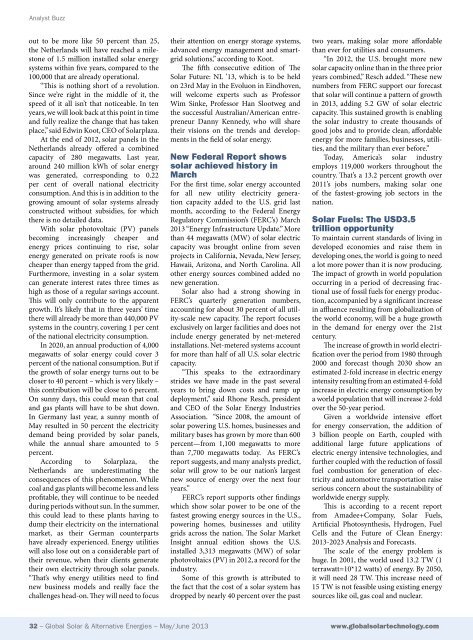Download the PDF - Global Solar Technology
Download the PDF - Global Solar Technology
Download the PDF - Global Solar Technology
You also want an ePaper? Increase the reach of your titles
YUMPU automatically turns print PDFs into web optimized ePapers that Google loves.
Analyst Buzz<br />
out to be more like 50 percent than 25,<br />
<strong>the</strong> Ne<strong>the</strong>rlands will have reached a milestone<br />
of 1.5 million installed solar energy<br />
systems within five years, compared to <strong>the</strong><br />
100,000 that are already operational.<br />
“This is nothing short of a revolution.<br />
Since we’re right in <strong>the</strong> middle of it, <strong>the</strong><br />
speed of it all isn’t that noticeable. In ten<br />
years, we will look back at this point in time<br />
and fully realize <strong>the</strong> change that has taken<br />
place,” said Edwin Koot, CEO of <strong>Solar</strong>plaza.<br />
At <strong>the</strong> end of 2012, solar panels in <strong>the</strong><br />
Ne<strong>the</strong>rlands already offered a combined<br />
capacity of 280 megawatts. Last year,<br />
around 240 million kWh of solar energy<br />
was generated, corresponding to 0.22<br />
per cent of overall national electricity<br />
consumption. And this is in addition to <strong>the</strong><br />
growing amount of solar systems already<br />
constructed without subsidies, for which<br />
<strong>the</strong>re is no detailed data.<br />
With solar photovoltaic (PV) panels<br />
becoming increasingly cheaper and<br />
energy prices continuing to rise, solar<br />
energy generated on private roofs is now<br />
cheaper than energy tapped from <strong>the</strong> grid.<br />
Fur<strong>the</strong>rmore, investing in a solar system<br />
can generate interest rates three times as<br />
high as those of a regular savings account.<br />
This will only contribute to <strong>the</strong> apparent<br />
growth. It’s likely that in three years’ time<br />
<strong>the</strong>re will already be more than 440,000 PV<br />
systems in <strong>the</strong> country, covering 1 per cent<br />
of <strong>the</strong> national electricity consumption.<br />
In 2020, an annual production of 4,000<br />
megawatts of solar energy could cover 3<br />
percent of <strong>the</strong> national consumption. But if<br />
<strong>the</strong> growth of solar energy turns out to be<br />
closer to 40 percent – which is very likely –<br />
this contribution will be close to 6 percent.<br />
On sunny days, this could mean that coal<br />
and gas plants will have to be shut down.<br />
In Germany last year, a sunny month of<br />
May resulted in 50 percent <strong>the</strong> electricity<br />
demand being provided by solar panels,<br />
while <strong>the</strong> annual share amounted to 5<br />
percent.<br />
According to <strong>Solar</strong>plaza, <strong>the</strong><br />
Ne<strong>the</strong>rlands are underestimating <strong>the</strong><br />
consequences of this phenomenon. While<br />
coal and gas plants will become less and less<br />
profitable, <strong>the</strong>y will continue to be needed<br />
during periods without sun. In <strong>the</strong> summer,<br />
this could lead to <strong>the</strong>se plants having to<br />
dump <strong>the</strong>ir electricity on <strong>the</strong> international<br />
market, as <strong>the</strong>ir German counterparts<br />
have already experienced. Energy utilities<br />
will also lose out on a considerable part of<br />
<strong>the</strong>ir revenue, when <strong>the</strong>ir clients generate<br />
<strong>the</strong>ir own electricity through solar panels.<br />
“That’s why energy utilities need to find<br />
new business models and really face <strong>the</strong><br />
challenges head-on. They will need to focus<br />
<strong>the</strong>ir attention on energy storage systems,<br />
advanced energy management and smartgrid<br />
solutions,” according to Koot.<br />
The fifth consecutive edition of The<br />
<strong>Solar</strong> Future: NL ’13, which is to be held<br />
on 23rd May in <strong>the</strong> Evoluon in Eindhoven,<br />
will welcome experts such as Professor<br />
Wim Sinke, Professor Han Slootweg and<br />
<strong>the</strong> successful Australian/American entrepreneur<br />
Danny Kennedy, who will share<br />
<strong>the</strong>ir visions on <strong>the</strong> trends and developments<br />
in <strong>the</strong> field of solar energy.<br />
New Federal Report shows<br />
solar achieved history in<br />
March<br />
For <strong>the</strong> first time, solar energy accounted<br />
for all new utility electricity generation<br />
capacity added to <strong>the</strong> U.S. grid last<br />
month, according to <strong>the</strong> Federal Energy<br />
Regulatory Commission’s (FERC’s) March<br />
2013 “Energy Infrastructure Update.” More<br />
than 44 megawatts (MW) of solar electric<br />
capacity was brought online from seven<br />
projects in California, Nevada, New Jersey,<br />
Hawaii, Arizona, and North Carolina. All<br />
o<strong>the</strong>r energy sources combined added no<br />
new generation.<br />
<strong>Solar</strong> also had a strong showing in<br />
FERC’s quarterly generation numbers,<br />
accounting for about 30 percent of all utility-scale<br />
new capacity. The report focuses<br />
exclusively on larger facilities and does not<br />
include energy generated by net-metered<br />
installations. Net-metered systems account<br />
for more than half of all U.S. solar electric<br />
capacity.<br />
“This speaks to <strong>the</strong> extraordinary<br />
strides we have made in <strong>the</strong> past several<br />
years to bring down costs and ramp up<br />
deployment,” said Rhone Resch, president<br />
and CEO of <strong>the</strong> <strong>Solar</strong> Energy Industries<br />
Association. “Since 2008, <strong>the</strong> amount of<br />
solar powering U.S. homes, businesses and<br />
military bases has grown by more than 600<br />
percent—from 1,100 megawatts to more<br />
than 7,700 megawatts today. As FERC’s<br />
report suggests, and many analysts predict,<br />
solar will grow to be our nation’s largest<br />
new source of energy over <strong>the</strong> next four<br />
years.”<br />
FERC’s report supports o<strong>the</strong>r findings<br />
which show solar power to be one of <strong>the</strong><br />
fastest growing energy sources in <strong>the</strong> U.S.,<br />
powering homes, businesses and utility<br />
grids across <strong>the</strong> nation. The <strong>Solar</strong> Market<br />
Insight annual edition shows <strong>the</strong> U.S.<br />
installed 3,313 megawatts (MW) of solar<br />
photovoltaics (PV) in 2012, a record for <strong>the</strong><br />
industry.<br />
Some of this growth is attributed to<br />
<strong>the</strong> fact that <strong>the</strong> cost of a solar system has<br />
dropped by nearly 40 percent over <strong>the</strong> past<br />
two years, making solar more affordable<br />
than ever for utilities and consumers.<br />
“In 2012, <strong>the</strong> U.S. brought more new<br />
solar capacity online than in <strong>the</strong> three prior<br />
years combined,” Resch added. “These new<br />
numbers from FERC support our forecast<br />
that solar will continue a pattern of growth<br />
in 2013, adding 5.2 GW of solar electric<br />
capacity. This sustained growth is enabling<br />
<strong>the</strong> solar industry to create thousands of<br />
good jobs and to provide clean, affordable<br />
energy for more families, businesses, utilities,<br />
and <strong>the</strong> military than ever before.”<br />
Today, America’s solar industry<br />
employs 119,000 workers throughout <strong>the</strong><br />
country. That’s a 13.2 percent growth over<br />
2011’s jobs numbers, making solar one<br />
of <strong>the</strong> fastest-growing job sectors in <strong>the</strong><br />
nation.<br />
<strong>Solar</strong> Fuels: The USD3.5<br />
trillion opportunity<br />
To maintain current standards of living in<br />
developed economies and raise <strong>the</strong>m in<br />
developing ones, <strong>the</strong> world is going to need<br />
a lot more power than it is now producing.<br />
The impact of growth in world population<br />
occurring in a period of decreasing fractional<br />
use of fossil fuels for energy production,<br />
accompanied by a significant increase<br />
in affluence resulting from globalization of<br />
<strong>the</strong> world economy, will be a huge growth<br />
in <strong>the</strong> demand for energy over <strong>the</strong> 21st<br />
century.<br />
The increase of growth in world electrification<br />
over <strong>the</strong> period from 1980 through<br />
2000 and forecast though 2030 show an<br />
estimated 2-fold increase in electric energy<br />
intensity resulting from an estimated 4-fold<br />
increase in electric energy consumption by<br />
a world population that will increase 2-fold<br />
over <strong>the</strong> 50-year period.<br />
Given a worldwide intensive effort<br />
for energy conservation, <strong>the</strong> addition of<br />
3 billion people on Earth, coupled with<br />
additional large future applications of<br />
electric energy intensive technologies, and<br />
fur<strong>the</strong>r coupled with <strong>the</strong> reduction of fossil<br />
fuel combustion for generation of electricity<br />
and automotive transportation raise<br />
serious concern about <strong>the</strong> sustainability of<br />
worldwide energy supply.<br />
This is according to a recent report<br />
from Amadee+Company, <strong>Solar</strong> Fuels,<br />
Artificial Photosyn<strong>the</strong>sis, Hydrogen, Fuel<br />
Cells and <strong>the</strong> Future of Clean Energy:<br />
2013-2023 Analysis and Forecasts.<br />
The scale of <strong>the</strong> energy problem is<br />
huge. In 2001, <strong>the</strong> world used 13.2 TW (1<br />
terrawatt=10*12 watts) of energy. By 2050,<br />
it will need 28 TW. This increase need of<br />
15 TW is not feasible using existing energy<br />
sources like oil, gas coal and nuclear.<br />
32 – <strong>Global</strong> <strong>Solar</strong> & Alternative Energies – May/June 2013 www.globalsolartechnology.com
















